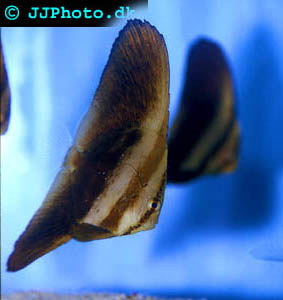Oribiculate Batfish
Platax orbicularis
Common name: Orbiculate Batfish, Round Batfish, Orbic Platax, Orbic Batfish.
Scientific name: Platax orbicularis
Max size: 20 in / 50 cm
pH: 8.1-8.4
Salinity: 1.020-1.025
Temperature: 72-78ºF (22-26°C)
The Orbiculate batfish is a nice fish for anyone who has a tank large enough to house them. This species changes appearance a lot during its lifetime and an adult specimen looks nothing like a juvenile one. Both coloration and body shape changes. Adult specimens have a very high profile reminding much of the body shape of freshwater angelfish and a yellow and brown body. Juvenile specimens have a much lower body more similar to that of a discus fish (a little more squared). The juvenile Orbiculate batfish has a silvery body with three black lines running vertically across it. You can see two lines on the front half of the body and one just in front of the tailfin.
This species is relatively hardy but can due to its size only be recommended to fish keepers with large aquariums. In the wild, Orbiculate batfish live singly, in pairs, in groups and in large schools and you can keep them as solitary fish, pairs, groups or schools in your aquarium as well. They are not reef safe as they will eat small fish and invertebrates as well as anemones and corals. The Orbiculate batfish is a friendly species and can be kept with most species that are large enough not to be considered food and that enjoy a similar setup. Don't keep with very aggressive fish like triggers.
The Orbiculate batfish is just like other batfish species susceptible to marine ich.
The Orbiculate batfish originates from the Indo Pacific Ocean. They can be found from the Red Sea and the east cost of Africa to the Tuamoto Islands. The northern limit for their distribution is the waters of Japan and the southern limit is the coast of southern Australia. This species has also been recorded off the coast of Florida in the Central Atlantic Ocean. It is not sure how the Orbiculate batfish was introduced into the Atlantic. This species is usually found at depths of 0-100 ft / 0-30 m.
Orbiculate Batfish care and aquarium setup
If you want to keep Orbiculate batfish you will need a very large aquarium. Minimum size is around 180 gallons / 700 L but a larger tank is better. It is important to keep them in a high tank as they grow much higher than they do long. A fully grown adult specimen should be provided with an aquarium that is at least 6-7 ft / 2 m high.
The most important thing to remember when decorating an aquarium for orbiculate batfish is to provide ample open space to swim in. They prefer sand as bottom substrate. The rest of the decoration is of lesser importance. Don't use anemones and corals unless you are ok with the batfish eating on them.
The aquarium should be well circulated and have a filter large enough to handle the waste produced by these large fishes. The Orbiculate batfish prefers a well lit aquarium but appreciates a shaded spot or two in the tank. Try to maintain a high water quality and stable water parameters.
Due to reasons explained above, this fish is not recommended for reef aquariums; it is suitable for "fish only" and "fish with live rock" aquariums.
Ideal conditions for the Orbiculate batfish is pH 8.1-8.4, salinity 1.020-1.025, and temperature 72-78ºF (22- 26°C).
Feeding Orbiculate Batfish
It is a predatory fish that eats small fish, invertebrates, anemones and corals. In an aquarium they should be fed a varied diet consisting of different types of meaty frozen and live food such as chopped up sea food. They can sometimes be trained to accept pellets. Feed your Orbiculate Batfish 2-3 times a day.
Breeding Orbiculate Batfish
We don't have any information regarding Orbiculate Batfish breeding. Juvenile fishes are however often found among the roots of mangrove trees and it is possible that the adult fish wanders in from open water to spawn among the mangroves to give their fry a good start in live. If that is the case, you might have to mimic such conditions for them to spawn. It is also safe to assume that breeding the Orbiculate Batfish would require a very large aquarium due to size of the adult fish.
Batfish Articles:
Redfin Batfish – Platax pinnatus
Longfin Batfish – Platax teira

